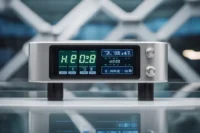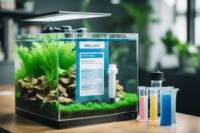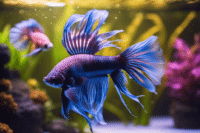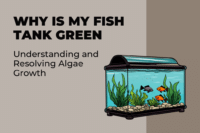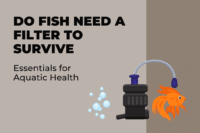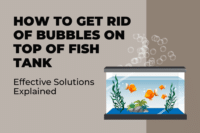Cleaning your fish tank without removing the fish might sound tricky, but it’s entirely doable with the right approach. By learning a few simple techniques, you can maintain a clean and healthy aquarium for your fish without stressing them out. This means happier fish and less work for you – a win-win situation!
One common method involves using a siphon or gravel vacuum to remove debris from the substrate. You can also clean the inside of the tank glass with an aquarium magnet cleaner. This allows you to remove algae without getting your hands wet or making your fish uncomfortable.
Regular maintenance helps keep the water clear and the fish healthy. A clean tank isn’t just nice to look at; it’s vital for your aquarium’s ecosystem. With these tips, you’ll find that keeping your fish tank clean is easier and more efficient.
Key Takeaways
- Clean the tank glass with an aquarium magnet cleaner.
- Use a siphon or gravel vacuum to remove debris.
- Regular maintenance ensures a healthy environment for your fish.
Understanding Your Aquarium’s Ecosystem
Keeping your aquarium’s ecosystem healthy is key to ensuring your fish thrive. Dive into recognizing signs of a dirty tank, understanding the role of beneficial bacteria, and balancing water parameters.
Recognizing Signs of a Dirty Tank
A dirty tank can cause serious problems for your fish. If you notice cloudy water, unpleasant smells, or algae buildup, your tank needs attention.
Cloudy Water: This can indicate excess waste or overfeeding. Check your filters and reduce food portions.
Algae Overgrowth: Use an algae scraper to clean the glass. Algae can block light, harming plants and stressing fish.
Unpleasant Smells: This is a sign of decaying organic matter or poor water quality. Start by performing a partial water change.
Regularly inspect your tank for these signs to maintain a healthy environment.
The Role of Beneficial Bacteria
Beneficial bacteria are your allies in maintaining water quality. These microorganisms break down harmful substances like ammonia and nitrite, turning them into less harmful nitrate.
- Ammonia: Your fish produce ammonia through waste. High levels are toxic and can cause illness.
- Nitrite: Bacteria convert ammonia to nitrite, which is also harmful in high amounts.
- Nitrate: Finally, other bacteria transform nitrite into nitrate, which is safer but should be kept low through water changes.
Maintaining a good bacterial balance prevents toxin build-up and keeps your fish healthy.
Balancing Water Parameters
Proper water parameters are vital for fish health. Regularly test and adjust:
pH Levels: Most freshwater fish thrive in a pH range of 6.5-7.5. Be sure to test with a reliable kit and adjust as needed.
Ammonia, Nitrite, and Nitrate: Use test kits to monitor these levels. Keep ammonia and nitrite at 0 ppm (parts per million) and nitrate below 20 ppm.
Temperature: Ensure the water temperature is suitable for your specific fish species, typically between 72-82°F (22-28°C).
By managing these factors, you create a stable environment where fish can live happily.
Taking care of your aquarium involves more than just cleaning; it’s about understanding and maintaining a balanced ecosystem to keep your fish healthy and happy.
The Cleaning Process
Keeping your fish tank clean is essential for the health of your fish. Below, you will find steps on how to clean your tank without removing your fish.
Preparation and Necessary Tools
Before you start, gather all the tools you’ll need. You’ll need a gravel vacuum or siphon to remove debris from the substrate. Have a bucket ready for the dirty water. An algae scraper or algae pad will help you remove algae from the glass. Don’t forget a water conditioner (dechlorinator) for treating new water.
Check that you have a clean sponge or toothbrush for scrubbing any decorations or rocks. It’s vital to use tools that are safe and won’t harm your fish or disrupt the environment.
Performing a Partial Water Change
To start, disconnect any electronic devices like heaters and filters for safety. Then, use your siphon to remove around 20-30% of the tank’s water. Place the end of the siphon in the bucket to collect the dirty water. Move the siphon through the gravel, cleaning it as it sucks up debris and waste.
Fill up the bucket with clean water and treat it with water conditioner. This ensures harmful chemicals are neutralised. Slowly pour the treated water back into the tank to avoid stressing your fish.
Cleaning Algae and Decorations
Algae can build up on surfaces and make your tank look dirty. Use an algae scraper or pad to clean the inside glass. For tough spots, a clean sponge or toothbrush can be useful. Gently scrub any rocks and decorations in the tank.
For the filter, clean the filter media to ensure good water quality. Be sure to follow the manufacturer’s instructions when cleaning or replacing parts.
Regular maintenance with these steps will keep your tank healthy and your fish happy.
Conclusion
Cleaning your fish tank without removing the fish might seem tricky at first, but it’s totally doable. Using a siphon to remove old water and replace it with fresh, dechlorinated water is key. Remember: Pour the new water gently to avoid shocking your fish.
Cleaning the inside glass is essential. An aquarium magnet cleaner works wonders and keeps your hands dry.
Tip: Use a motorized gravel vacuum to clean the gravel. This minimizes stress for your fish.
Monthly tasks are crucial. Change the activated carbon in the filter, clean algae with a scraper, and trim any live plants.
Want a pro tip? Let water sit overnight so chlorine evaporates, or treat it with dechlorinator before adding it to the tank. Pour the treated water slowly to mix it well with tank water.
By following these steps, you’ll keep your fish happy and your tank sparkling clean without ever moving your fish! Happy fish-keeping!

